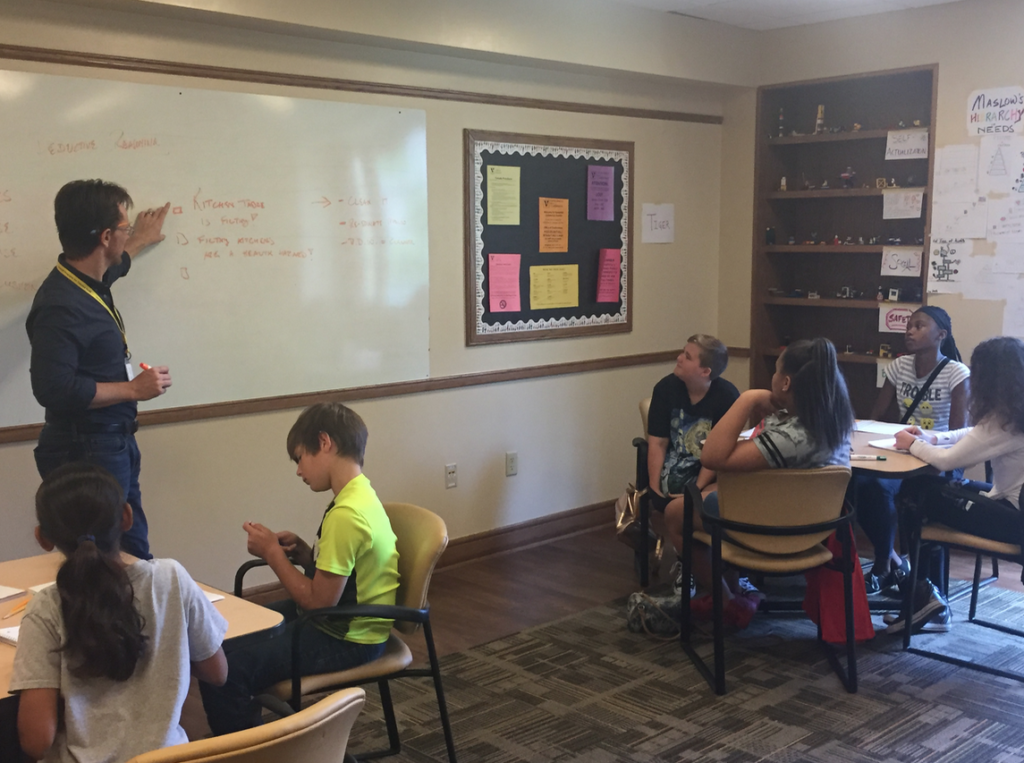Summer Career Connections at SAVY 2018: Session 5, Day 3 – The Power of Persuasion (Rising 7th)
Day three commenced with a few iterations of The Line, with students ultimately embodying an imagined six thousand year old kitchen table. We used the scenario of the table as a jumping-off point to identify problems in our hypothetical kitchen and to brainstorm potential solutions; in so doing, we illustrated that any problem in a community can quickly become a social or political issue. Solutions ran from the practical to the wildly impractical, which allowed students to evaluate the merits of arguments for aggregate value (the sum total of positive attributes) and for lexographic value (when a singular issue or point clearly trumps others).
Students were encouraged to create stories from personal experience to foster identification with the (truly odd) problems of the dirty kitchen – which we eventually better described as a severe health risk, a hazardous space, or possibly a crime scene; your children are very humorous and have wild imaginations!
After, we watched a short PBS video entitled “How to Argue” which explored the philosophy of argumentation, including premises, deductive arguments, entailment, validity and soundness. This enabled the students to deconstruct their solutions for the problem of the kitchen table and re-construct more valid arguments.
We introduced another game to our repertoire, “Bop,” intended to hone skills of communication and focus. Communication is a transactional process, and we literalized this model by “tossing” a word around the circle (not unlike Hot Potato). Sometimes the words were short and monosyllabic – “Boosh!” was a favorite – while we also reinforced classroom vocabulary by tossing around words like “lexographic.” Bop is a simple, brief game, but the intention is clear: to be seen and heard, and one must look and listen.
After lunch, we watched selections from three music videos by the band OK Go, featuring a Rube-Goldberg machine, a stunt car in the desert, and a zero-gravity plane ride. We used the semi-impressionistic imagery of the videos to illustrate the importance of identifying specific needs of an audience when constructing an argument; upon discovering that all three videos were, in fact, subsidized by various companies (an insurance company, an automaker, and an airline), students role played, constructing persuasive “pitches” to obtain funding for the videos from each organization.
We furthered our exploration of Monroe’s Motivated Sequence, unlocking the power of “previewing an argument” during the Plan/Satisfaction stage. We used a simple device to construct arguments about favorite desserts and books, after which the the students were given their final prompt: Students were to imagine that on Friday we would watch a film in class, with each student creating a strong persuasive argument for the film of their choice. Required criteria were that each film be appropriate, entertaining, and related to course content. After venturing to the computer lab to collect empirical data in support of our arguments, students crafted elaborate and sophisticated persuasive speeches. Several of the students were able to complete and share their speeches before the end of the day – and, though the students’ made compelling cases, I did remind the class that the prompt was hypothetical in nature, and that, no, we will not be watching a movie together on Friday!
We are having a blast this week. Your students are learning to craft strong persuasive arguments, and to envision how the tools they are working with can apply to any number of career paths. They are courageous and fun, and I am thoroughly enjoying their ideas and their spirit. Tomorrow we’ll dig a bit deeper (we’ll cover the dangers of various argument fallacies), and I imagine that by week’s end you will be impressed by your child’s ability to construct incredibly sound persuasive arguments.
-Mr. Lee
Photo From Our Day
